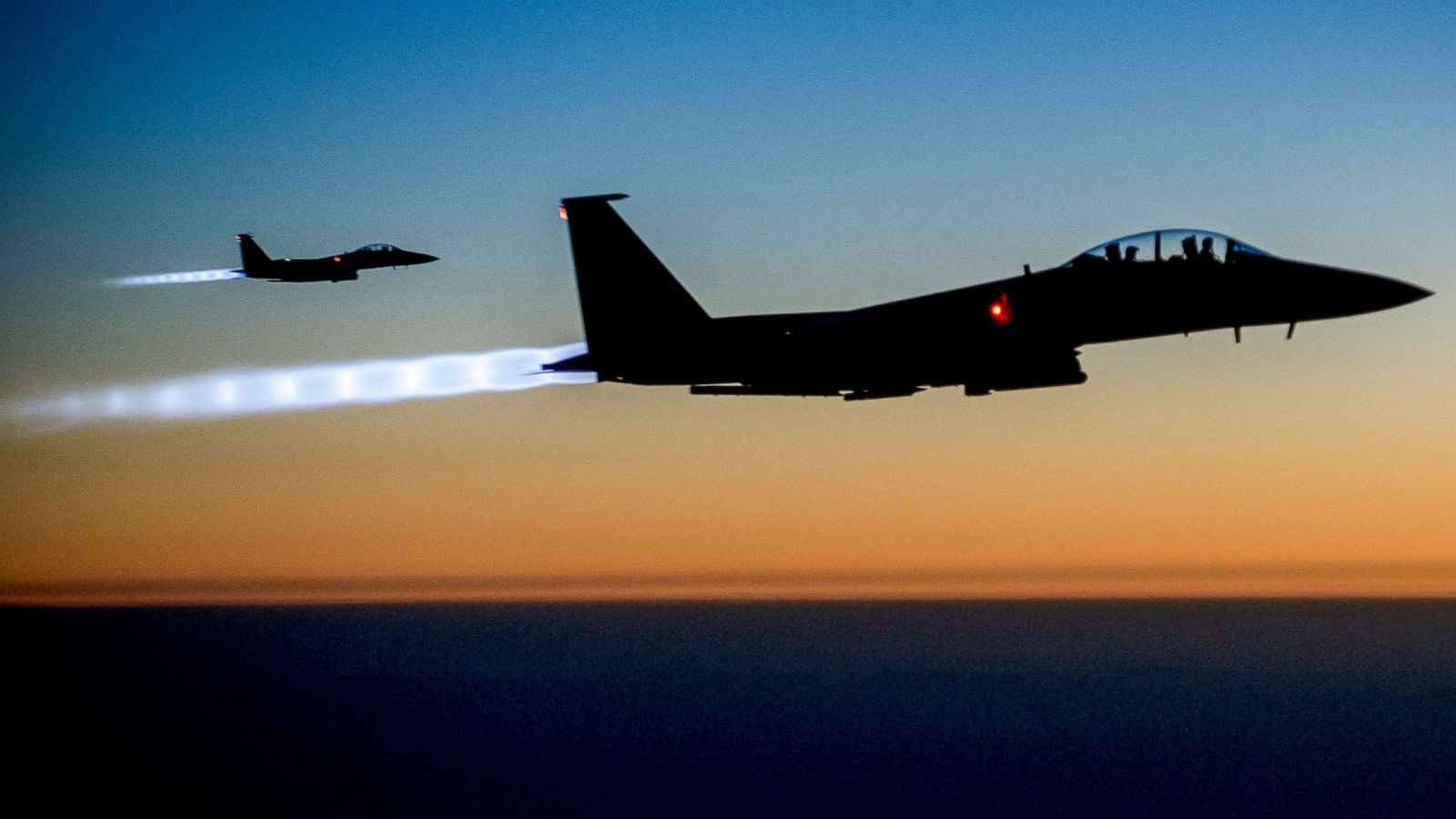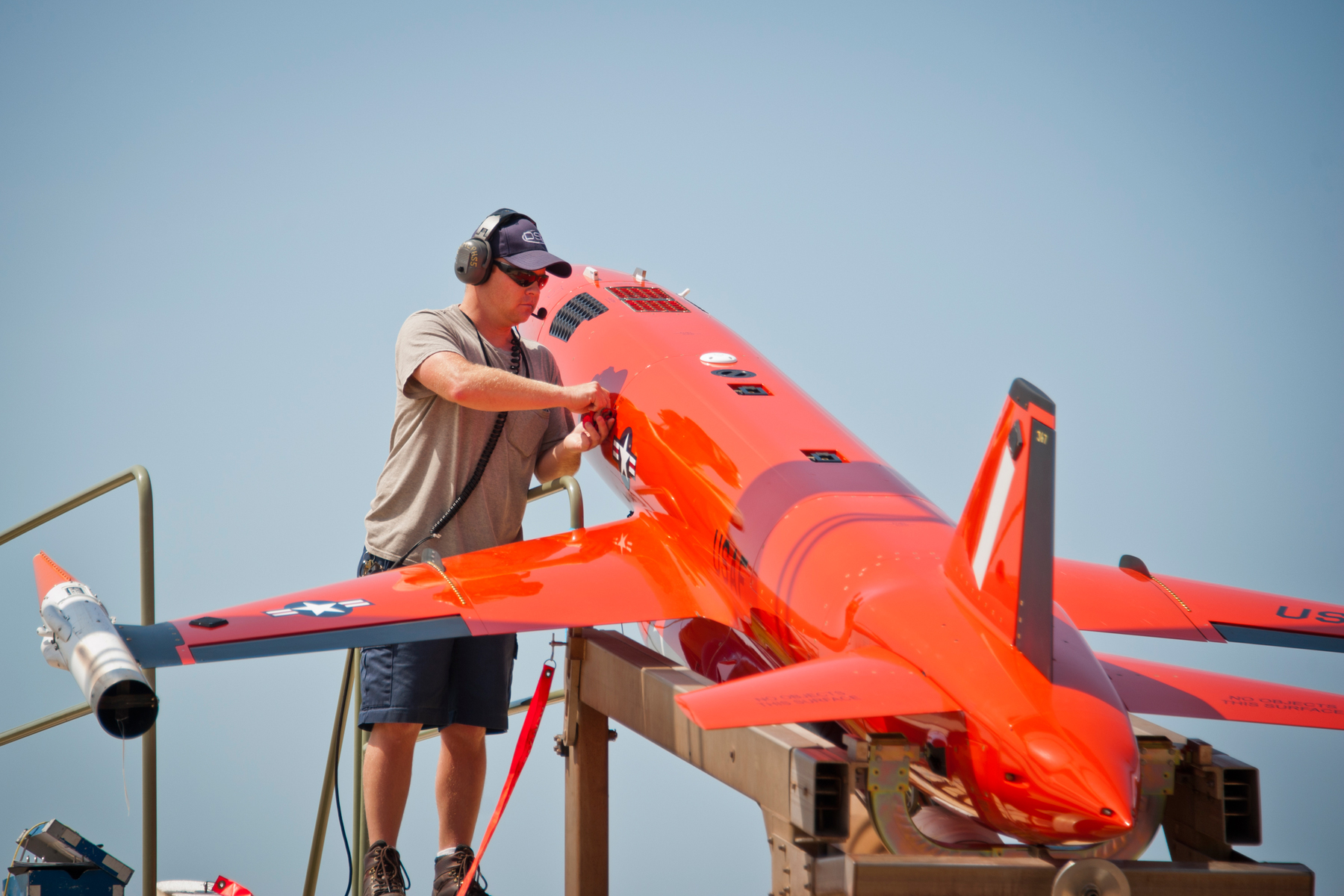Us Military Targets - A drone view of a target in the desert. The "kill chain" links video analysts, jet fighter pilots and armed drone operators. Photo: Main_sail/Getty Images/iStockphoto
Amidst bean fields in Kansas, military analysts watch live video footage of suspects' lives...and mark their deaths. Killings and related civilian casualties take an emotional toll
Us Military Targets
In a dimly lit room at McConnell Air Force Base in south-central Kansas, analysts from the National Guard's Intelligence Group watch live drone footage from war zones in the Middle East.
Facebook Catches Iranian Spies Catfishing Us Military Targets
During combat, analysts become part of a "kill chain" - analyzing live drone video and then reporting what they see - via chat with jet fighter pilots, Predator and Reaper armed drone operators, and ground troops.
They are waging war with drones thousands of miles away from the battlefields. They don't fly drones or shoot rockets. They monitor video of enemy fighters and tell the fighters what they see. They say the job helps kill terrorists, including ISIS.
The group does this work in the middle of America, on an air base surrounded by flat cow pastures and soybean fields. The 184th Reconnaissance Wing of the Kansas Air National Guard began this work around 2002. Until last year, most people in Kansas knew nothing about their role in the drone war.
The work is strictly confidential. They say they see things in these drone footage that no one wants to see. Sometimes terrorists behead civilians. Sometimes civilians are killed accidentally during missions that Kansas helps coordinate.
Kremlin: U.s. Patriot Systems In Ukraine Would Be Legitimate Target
They suffer from these deaths. One of the pilots says that the phrase "Don't push the button" is heard most often in the fight against drones.
"You see [enemy fighters] kissing their children and their wives and then walking down the street," said Sgt. "Once they get over that hill, the missile will be fired."
The analysts work in the top-secret Sensitive Compartmented Information Facility (SCIF) at McConnell Air Force Base in Wichita. Photo: Kansas Air National Guard 184th Reconnaissance Wing

Critics of the drone war describe it as an impersonal assassination made at an unknown additional cost. Those critics, including those who study civilian casualties in the Middle East, say the actual death toll is thousands higher than the total number recognized by the United States and its coalition allies. Airwars.org said in a statement on its website: "By all accounts, 2017 was the worst year for civilians in the fight against ISIS as the fighting moved deep into Iraqi and Syrian cities." Despite the coalition's insistence that it is waging "the most precise war in history," Airwars estimates that coalition operations killed at least 3,875 non-combatants between 2017 and November.
Rocket Attack, 3rd In 3 Days, Targets Us In Iraq: Army
The Bureau of Investigative Journalism estimates that 4,413 US strikes in Afghanistan, Pakistan, Somalia and Yemen since about 2002 have killed 4,413 people. The Bureau believes that 1,488 people are civilians, including 331 children.
Reporters from the New York Times Magazine wrote in a November article called The Uncounted that they spent 18 months personally visiting 150 coalition strike sites in Iraq. They concluded that one in five strikes killed civilians - a death toll they said was 31 times higher than military estimates.
What the Kansas pilots describe is a different story. In their opinion, they are saving civilians and military personnel. They are fighting terrorists who want to come here.
The death of the enemy does not concern them. "Hard terrorists, they all made a choice," says the officer, who identified himself as Major Jeffrey. "We protect the boys and girls of the earth."
Ukrainian Officials Drew On U.s. Intelligence To Plan Counteroffensive
But the death of civilians is a heavy burden on them. "To talk about collateral damage sounds callous," said Col. David Weishaar, commander of the 184th Division. "This is human life. We're doing everything we can to mitigate that."
Last Friday, three Weishaar airmen gathered in an empty concrete conference room at the air base and gathered around a small round table. They give ranks and names: Staff Sergeant Don, Major Jeffrey, Staff Sergeant James.
"The technology we use is just crazy, it's so good," Geoffrey begins. Jeffrey says drone commanders in the Middle East can monitor enemy combat operations — for months, if necessary.

They park drones in the air above surveillance targets and program them to "roam". Many drones can orbit for 14 hours fully armed. Operators replace them with a fueled drone when the previous drone runs low.
From Deep In The Iraqi Desert, A New U.s. Fire Base Targets Isis In Syria
Boys gather near the wreckage of a car destroyed by a US drone targeting suspected al-Qaeda fighters in the Shabwa province of southeastern Yemen. Photo: Khaled Abdullah/Reuters
In Kansas, at the SCIF (Sensitive Compartmented Intelligence Facility), members of Colonel Brad Hilbert's team look at dozens of screens. One eight-hour shift would observe several targets and then hand over observation to the next shift. Several missions are carried out at the same time.
While the enemy fighters walk around with their weapons, the group studies their movements. They can monitor one person, one building, or a small area. Drones circle high and invisible, providing a crisp, high-tech image.
"Sometimes I say we're fighting with laser beams versus people hitting each other with sticks," Jeffrey says.
A Map Of Potential Nuclear Weapons Targets From 2017 In The Event Of A 500 Warhead And 2,000 Warhead Scenario. Targets Include Military Installations, Ammunitions Depots, Industrial Centers, Agricultural Areas, Key Infrastructures,
Most of what they watch is boring. "Sometimes for a month, they watch one pile of sand every day," says their chaplain.
But sometimes they see that the enemy is about to attack American troops. The commanders decide to "neutralize" him. When commanders order an attack, Kansans become one link in a kill chain that can include armed Reaper and Predator drone operators, fighter pilots, ground artillery commanders and commanders authorized to approve or reject attacks.
Before starting work, ISR analysts undergo a year of training. The top priority, Don says, is to never shoot where civilians may be in danger. None of the aviators wanted to describe the specifics of the battle in which he participated.

But one of the 184th's former commanders, Maj. Janell Blaufuss, has earned the battle commendation the unit has produced this year.
Two Rockets Target Us Army Base In Eastern Syria: Centcom
In 2009-2012, Blaufus took part in 425 combat missions in Iraq, Afghanistan and other countries. She helped kill high-ranking Taliban fighters in Afghanistan, insurgents in Iraq, and others. They helped neutralize "92 people of special value, found 398 improvised explosive devices - saved lives." Do not press the button
During a 2011 mission in Afghanistan, Hilbert analysts stopped a strike that could have killed civilians. This is one story Col. Joe Jabara would like to see more of in the news.
The 2011 mission began with some trepidation, Gilbert says. American soldiers and planes were shot every day.
"Our [plane] was shot down by an A [A-gun], so we searched hard for it," says Lt. Col. Geoff, another 184 Squadron commander. Then a drone camera showed that commanders overseas were sure it was a hidden killer.
The Kill Chain: Inside The Unit That Tracks Targets For Us Drone Wars
"It was an irrigation pipe with a tent over the pipe," says Gilbert. “The plane operators thought it was a triple A. It looked like a piece of triple A.
"It was about finding a potential threat," says Hilbert. "But our people were adamant, 'No, it's not.'
"The next day, the ground forces were able to verify that it was a hut where people lived," says Gilbert.

A Yemeni man looks at the graffiti of a US drone after al-Qaeda in Yemen confirmed the death of its leader in a US drone strike in Sana'a, Yemen, June 16, 2015. Photo: Yahya Arhab/EPA
U.s. Army Pvt. William Roebuck, Right, Reviews His Targets With A German Army Officer During Qualification
A leading analyst of drone warfare is Micah Zianko, an author and former analyst at the Council on Foreign Relations. He lists dozens of officers among his sources and writes about drone successes. He wrote that drone warfare has crippled the ability of al-Qaeda and other groups to carry out international terrorism.
Not only that, he said, drone strikes raise other issues: they are turning the population against America. Most of the warriors killed are low level.
"The military claims that we use drones for force protection of our troops on the ground or to fight terrorism," he said. “But in Afghanistan, most of our drones are protecting Afghan forces on the ground. In Somalia, we kill people who pose a threat to the Somali forces.
"Why are the CIA and JSOC [US Army's Joint Special Operations Command] functioning as the Somali government's air force?" Zenek asked. "It's not really about fighting terrorism."
U.s. Weighing Whether To Go After More Targets In Afghanistan
Zenka says the U.S. needs to stop so-called "signature strikes" (a type of strike often coordinated by video analysts from Kansas). These attacks target unidentified militants based on their behavior and personal networks. Zianko argues that the military should "limit targeted killings to a limited number of specific terrorists with transnational ambitions."
In addition to Zenk, some thinkers around the world argue that there is more to worry about than victims. With the proliferation of anti-drone technology, physicist Stephen Hawking and inventor Elon Musk said this month that we are heading for a dangerous robot war and an artificial intelligence arms race.
The analysts work in the top-secret SCIF room at McConnell Air Force Base in Wichita. Photo: Courtesy of Kansas photo
Us military careers, military pop up targets, military targets, military range targets, military zero targets, military qualification targets, military sighting targets, printable military targets, military aircraft for ground targets, military paper targets, military surplus targets, military silhouette targets



0 Comments